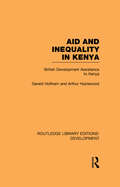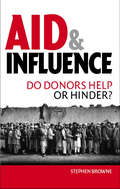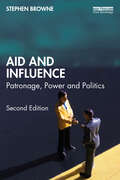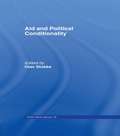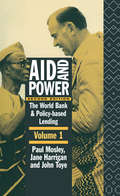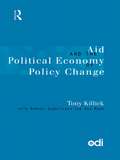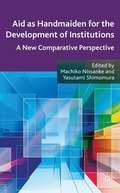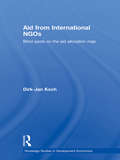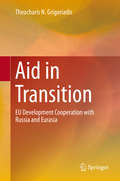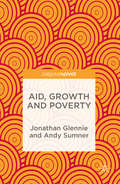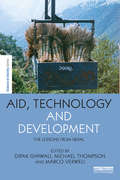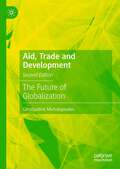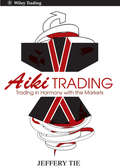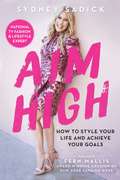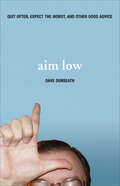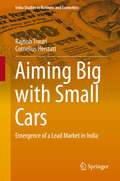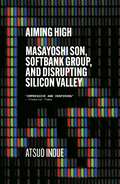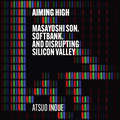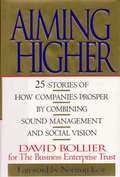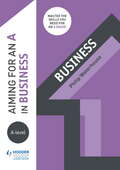- Table View
- List View
Aid and Inequality in Kenya: British Development Assistance to Kenya (Routledge Library Editions: Development)
by Gerald Holtham Arthur HazelwoodThis reissue, first published in 1976, considers the rapid rate of economic growth in Kenya, combined with its apparent political stability, to determine whether or not this is indeed a case of ‘growth without development’ and, if so, where the responsibility for aid lies in this situation. The book concludes that while Kenyan growth has not been to an ideal pattern, accompanied by an increase in inequality, there is little or no reason to believe that living standards have not improved. It examines the impact of aid on Kenya’s progress at both the microeconomic and macroeconomic level and provides an institutional study of the impact of aid on Kenyan Government policy formation and administration and a discussion of British aid’s political purposes and influence in Kenya. The authors conclude that some of the effects predicted by the critics of aid are visible, but that the net effect on general living standards has been strongly positive, concluding that the problems constitute a case for improving aid procedures, but not against aid itself.
Aid and Influence: Do Donors Help or Hinder?
by Stephen BrowneAid is always a means of influence: political, commercial, military and security-related. Some influence is benign, but much of it is coercive, even 'imperialistic'. Given the nature of aid, its effectiveness should be judged not only in developmental terms, but in terms of international relations. Even donors agree that, on both counts, the returns are meagre. This book, drawing on the author's 30 years of field experience, proposes two kinds of solution: donors should climb down from paternalistic central planning practices and support public goods that are neutral and beneficial ? cancellation of debt, fair trade, responsible economic governance, vaccine production, peace-making and peace-keeping. For their part, developing countries should follow the example of the most successful among them: recognize the true costs of 'free' aid, exercise their prerogative to choose their development partners and start paying their own way.
Aid and Influence: Patronage, Power and Politics
by Stephen BrowneThis book turns the argument about aid effectiveness on its head. Since development assistance is inherently self-interested, a source of soft power, political manipulation and commercial opportunity, its real effectiveness could arguably be judged by the strength of donor influence and not by development impact. Its subjective nature means that its impact on development is often weak, mainly short-term and confined to limited and specific contexts. Aid as influence was prevalent during the Cold War era. The connection is equally strong in this century’s newly bipolar world in which the contest is between western donors led by the United States, and China which is spending hundreds of billions of dollars on infrastructure as a means of influence in the global South. Influence permeates both bilateral and multilateral aid and in parallel with official aid, the rise of global philanthropy has seen it taken up by some of today’s billionaires. The response by donors to the growing havoc caused by the three Cs – conflict, climate change and COVID-19 – confirms the main findings of the book, which concludes by outlining what aid without influence would look like. This book draws on the author's 40 years of experience of the aid industry and will be essential reading for development students, practitioners and policy makers alike.
Aid and Political Conditionality (Routledge Research EADI Studies in Development #No. 16)
by Olav StokkeForeign aid has increasingly become subject to political conditionality. In the 1980s some institutions made aid dependent upon the recipient countries' economic policy reforms. Market liberalisation was the primary instrument and objective. In the 1990s such conditionality was brought one step further; aid was now linked to political reforms, affecting recipient countries' governing systems, requiring democracy, human rights and 'good governance'. This volume looks at these developments and considers the conditionality policies of several European aid donors. Such policies are also considered from recipient perspectives, both from the Third World and Russia, and the issue is also considered from a historical perspective.
Aid and Power - Vol 1: The World Bank and Policy Based Lending
by Jane Harrigan Paul Mosley John ToyeWhen the major aid organizations made flows of aid conditional on changes in policy, they prompted an extensive debate in development circles. Aid and Power has made one of the most significant and influential contributions to that debate. This edition has been revised to take account of changes within the World Bank itself and the extension of policy based lending to the formerly socialist economies of east and central Europe.
Aid and the Dutch Disease in Low-Income Countries: Informed Diagnoses for Prudent Prognoses
by Mwanza NkusuFinancial report from the IMF
Aid and the Political Economy of Policy Change
by Tony KillickThis volume looks at the effectiveness of conditionality in structural adjustment programmes. Tony Killick charts the emergence of conditionality, and challenges the widely held assumption that it is a co-operative process, arguing that in fact it tends to be coercive and detrimental to development objectives. Through detailed case studies of twent
Aid as Handmaiden for the Development of Institutions
by Machiko Nissanke Yasutami ShimomuraThrough comparative studies of aid-supported infrastructure projects in East Asia and Sub-Saharan Africa, the book examines how aid could assist development processes by facilitating development of local endogenous institutions.
Aid for Elites
by Mark MoyarCurrent foreign aid programs are failing because they are based upon flawed assumptions about how countries develop. They attempt to achieve development without first achieving good governance and security, which are essential prerequisites for sustainable development. In focusing on the poorer members of society, they neglect the elites upon whose leadership the quality of governance and security depends. By downplaying the relevance of cultural factors to development, they avoid altering cultural characteristics that account for most of the weaknesses of elites in poor nations. Drawing on a wealth of examples from around the world, the author shows that foreign aid can be made much more effective by focusing it on human capital development. Training, education, and other forms of assistance can confer both skills and cultural attributes on current and future leaders, especially those responsible for security and governance.
Aid from International NGOs: Blind Spots on the AID Allocation Map (Routledge Studies in Development Economics)
by Dirk-Jan KochInternational NGOs are increasingly important players within the new aid architecture but their geographic choices remain uncharted territory. This book focuses on patterns of development assistance, mapping, while analysing and assessing the country choices of the largest international NGOs. Koch's approach is interdisciplinary and uses qualitative, quantitative and experimental methods to provide a clear insight in the determinants of country choices of international NGOs. The book aims to discover the country choices of international NGOs, how they are determined and how they could be improved. This work, which uses a dataset created specifically for the research, comes to the conclusion that international NGOs do not target the poorest and most difficult countries. They are shown to be focussing mostly on those countries where their back donors are active. Additionally, it was discovered that they tend to cluster their activities, for example, international NGOs also have their donor darlings and their donor orphans. Their clustering is explained by adapting theories that explain concentration in for-profit actors to the non-profit context. The book is the first on the geographic choices of international NGOs, and is therefore of considerable academic interest, especially for those focusing on development aid and third sector research. Furthermore, the book provides specific policy suggestions for more thought-out geographic decisions of international NGOs and their back donors.
Aid in Transition: EU Development Cooperation with Russia and Eurasia
by Theocharis N. GrigoriadisThis book is the one of the first to address aid effectiveness as a political and comparative economics question. Since the collapse of the Soviet Union and the transition of its republics to market structures and more representative forms of government, the European Commission has recognized the necessity of a closer economic cooperation with Russia, Ukraine and Kazakhstan, the three largest economies of the former Soviet Union. This book suggests that the foreign aid of the European Union provided a set of reform incentives to post-Soviet planners. It created the grounds for the institutional and social transformation of the bureaucracy at both central and regional levels by integrating it into the aid allocation process. In Russia, Ukraine and Kazakhstan, the observed subordination of NGOs to the developmental priorities of the bureaucracy occurred at the expense of diversity and political openness. Nevertheless, this reality led to the emergence of transnational sovereignty partnerships that reduced poverty for the general population and motivated both bureaucrats and entrepreneurs to cooperate. Empirical models alone are not sufficient to delineate all the aspects of principal-agent relationships in post-Soviet bureaucracies. This is why formal modeling and analysis of qualitative data are extremely useful. Evaluation reports indicate the problems and challenges faced by aid bureaucrats and suggest that the weakly institutionalized environments of Ukraine and Central Asia/Kazakhstan are less conducive to aid effectiveness than the heavily bureaucratized environment of Russia. The proposed incentives system for the allocation of foreign aid links EU foreign policy with bureaucratic decision-making and reflects the choice sets of the donor and the recipient. Multilevel definitions of aid effectiveness are provided in the course of the book chapters.
Aid, Debt Relief, and Trade: An Agenda for Fighting World Poverty (A)
by Laura Alfaro Renee Kim Eric WerkerAt the 2005 Group of Eight summit, world leaders agreed to relieve the world's poorest countries' debt burden and double aid to Africa by 2010. The announcement raised questions whether debt relief would really help the poor. By examining past aid trends and policies of multilateral institutions, such as the International Monetary Fund and the World Bank, this case also questions whether aid can allow poor countries to break their vicious cycle of poverty, and/or how aid can be used effectively.
Aid, Growth and Poverty
by Andy Sumner Jonathan GlennieThe authors discuss the impact of foreign aid and tackle the question of why assessing the impact of aid isso difficult. The authors focus on peer-reviewed, cross-country studies published overthe last decade and draw together some global-level assessments, considering the context and conditions under whichaid might be said to 'work'. Glennie and Sumner argue that the evidence in four areas shows signsof convergence that may have direct relevance for policy decisions on aid andfor aid effectiveness discussions. These are as follows: Aidlevels (meaning if aid is too low or too high); Domestic political institutions(including political stability and extent of decentralisation); Aid composition(including sectors, modalities, objectives and time horizons); and Aidvolatility and fragmentation. Notably, this study finds that there is no consensus that theeffectiveness of aid depends on orthodox economic policies.
Aid, Technology and Development: The Lessons from Nepal (The Earthscan Science in Society Series)
by Dipak Gyawali, Michael Thompson and Marco VerweijOver the last 50 years, Nepal has been considered an experiential model in determining the effectiveness and success of global human development strategies, both in theory and in practice. As such, it provides a rich array of in-depth case studies in both development success and failure. This edited collection examines these in order to propose a novel perspective on how human development occurs and how it can be aided and sustained. Aid, Technology and Development: The lessons from Nepal champions plural rationality from both a theoretical and practical perspective in order to challenge and critique the status quo in human development understanding, while simultaneously presenting a concrete framework with which to aid citizen and governmental organisations in the galvanization of human development. Including contributions by leading international social scientists and development practitioners throughout Nepal, this book will be of great interest to students, scholars and practitioners working in the field of foreign aid and development studies.
Aid, Trade and Development: 50 Years of Globalization
by Constantine MichalopoulosThis enlightening book offers a comprehensive historical analysis of the main development challenges of the last half century and the international community's response through aid and trade. Much has happened: the oil crises of the 1970s, the debt crises of the 1980s, the break-up of the Soviet Union in the 1990s, the Millennium Development Goals, the onslaught of Globalization and the rise of its opponents since the financial crisis of the 2000s. Through it all, development has spread and global poverty declined. The volume assesses the contributions and coherence of developing and developed country policies and the role played by global institutions entrusted with responsibilities to enhance trade and support development. The volume concludes with a focus on the prospects for the future and the changes needed to make globalization more equitable. With 50 years of professional experience in the World Bank, the WTO and bilateral aid agencies, Michalopoulos brings an insider's perspective on the workings of these institutions and what needs to be done to make them more effective and responsive to changing global needs.
Aid, Trade and Development: The Future of Globalization
by Constantine MichalopoulosThis volume presents a broad sweep of modern economic history underpinning aid, trade, development and globalization in the last half century and the salient challenges facing the global community today. The author draws on his long years as an academic and development practitioner to recommend what needs to be done to cope with the backsliding of the fight against global poverty, fractured geopolitics and the threats to the multilateral economic order. The new, revised edition analyses how unilateralism, rising protectionism and the Covid-19 pandemic seriously threaten global sustainable development. It concludes with recommendations on the policy changes needed to make globalization more equitable and development more sustainable. This book will be of interest to researchers and students of economic development and economic history, as well as all those concerned about global inequality and sustainability.
Aiki Trading: The Art of Trading in Harmony with the Markets (Wiley Trading #15)
by Jeffery TieA great reference for all beginner traders. Aiki Trading will look at a robust method to understand what the market is doing in a specified timeframe. Essentially, markets are either trending up, trending down, or is in sideways or range bound congestion. Chapters are devoted to each of these three conditions, and the concepts are explained in depth. In addition, specific trading strategies will be explored for the different market conditions. These strategies are what I define as high probability, low risk trading strategies that have higher probability of success because it conforms to the nature of how markets behave. With more than 25 years of experience in financial markets, Jeffery's stock market career began in 1977 with JM Sassoon and continued with Kim Eng Securities. During his time in Stock-broking, Jeffery witnessed many cycles of boom and bust, including the 1987 meltdown in worldwide equity markets. In 1997, Jeffery joined Refco Singapore. During this time he developed new expertise in International Futures Markets and FX. Jeffery joined CMC in April 2007. He was responsible for the content and presentation of CMC's educational programmes. And he is currently the Resident Trainer with SGX Academy, and is based in Singapore.
Aim High: How to Style Your Life and Achieve Your Goals
by Sydney SadickTV fashion and lifestyle expert Sydney Sadick (TODAY, E!, Inside Edition, Good Morning America) offers an indispensable guide to finding your unique style—from the inside out. Fashion is full of highs and lows. We&’ve become experts at blending the two together—a Gucci belt with a blazer from Zara, a Chanel bag with an old pair of Levi&’s—but fashion is so much more than what you wear, how you look, or how much money you spend. In Aim High, style savant and fashion expert Sydney Sadick delivers an important message for women everywhere: what you wear on the outside can influence who you are and how you feel, and help you live a more meaningful life. At just 26, Sydney has experienced enough fashion highs (and lows) to last a lifetime. Combined with her experience interviewing some of the world&’s most coveted celebrities, designers, and stylists, she uses her insider knowledge and candid voice to break down fashion like you&’ve never read before. Sydney goes behind her scenes, from the blog that started it all (created at 1 a.m. from her college dorm), to the first time she interviewed a celebrity (Rihanna, who else?), to every wardrobe malfunction and challenge in between. You&’ll learn:· How personal style and what you wear can influence your mood· How to live a fulfilled life you love—even when your weight fluctuates· How to pack like a fashion expert· The remedy for the &“I have nothing to wear&” syndrome· How to dress for your Bumble profile or Zoom date (you&’re welcome)Aim High is a relatable, heart-filled, and inspiring blend of unfiltered stories and expert advice to help you live fearlessly, dress effortlessly, and find your style from within.
Aim Low: Quit Often, Expect the Worst, and Other Good Advice
by Dave DunseathThis parody of motivational self-help books advises the reader to keep expectations low in order to find true satisfaction in life.Why should you strive to aim low? Because every time you aim low, you’ll feel like you’ve died and gone to Disneyland. You’ll be in a place where you’re never concerned about hard work, where you never feel guilty for goofing off all day, where nobody expects anything from you, where choosing to eat a third corn dog—or not—will be the hardest decision of your day.Aiming low is as easy as breathing. You can practically do it without thinking. And all the skills required to get there—like quitting or making excuses—take less time to learn than you might imagine. All you really need is this book and the stark realization that you don’t really want to “be all that you can be” (what—are you crazy?? that’s the Army, for crying out loud). In fact, your expectations can go so low that anything you do achieve is completely surprising.Anytime you hear someone say it’s a win-win situation, they either don’t know all the facts or they have a stuttering problem.Admit your mistakes and you will mature and grow. Don’t admit them and you might get away with it.Hope is like a crutch. Once you start relying on it, you’ll be too afraid to make a move without it. Crutches are only good for two things: getting awesome parking at the mall and sympathy dates with hot chicks. Otherwise, they’ll just slow you down.Whoever said nothing is easy has never tried quitting.
Aiming Big with Small Cars: Emergence of a Lead Market in India (India Studies in Business and Economics)
by Cornelius Herstatt Rajnish TiwariThis book focuses on the small car segment of India's automotive industry to explain the emergence of lead markets. The authors contend that the current understanding of lead markets does not sufficiently explain the business practices that are born out of the intensified globalization of innovation. Lead markets are considered crucial for the global diffusion of new products and this book investigates whether sustainable lead markets can also emerge in developing economies, and if so, under which conditions. The authors question the conventional wisdom and propose updates and extensions to the lead market theory to better reflect the changing ground realities on ground.
Aiming High: Masayoshi Son, SoftBank, and Disrupting Silicon Valley
by Atsuo Inoue__________*Picked by the Financial Times as a Best Read of 2021*'I have no intention of making small bets' - Masayoshi SonIn order to understand what's happening in Silicon Valley, you just need to look at Masayoshi Son. __________There is no one in the world right now who is in a better position to influence the next wave of technology than Masayoshi Son. Not Jeff Bezos, not Mark Zuckerberg, not Elon Musk. They might have the money, but they lack Masa's combination of ambition, imagination, and nerve. Masayoshi Son is the most powerful person in Silicon Valley. As CEO and founder of the Japanese investment firm, SoftBank Group, 'Masa' has invested in some of the most exciting and influential tech companies in recent memory - Uber, WeWork, ByteDance, and many others. Prior to that, he was known as one of the first investors in Alibaba and Yahoo!He has an audacious vision for the future and one that is unmatched in the tech industry. Aiming High provides insight into this charismatic and visionary leader. Originally published in Japan, this book charts Son's rise from a Korean immigrant who left Japan at 16 to becoming one of the wealthiest people in the world. With unprecedented access to Son, including exclusive interviews, this book creates an authoritative account of how SoftBank Group and it's visionary and charismatic CEO is shaping the future of tech. __________
Aiming High: Masayoshi Son, SoftBank, and Disrupting Silicon Valley
by Atsuo InoueThe first ever biography of Silicon Valley's legendary investor and SoftBank's founder, chairman and CEO.'I have no intention of making small bets' - Masayoshi SonIn order to understand what's happening in Silicon Valley, you just need to look at Masayoshi Son. __________There is no one in the world right now who is in a better position to influence the next wave of technology than Masayoshi Son. Not Jeff Bezos, not Mark Zuckerberg, not Elon Musk. They might have the money, but they lack Masa's combination of ambition, imagination, and nerve. Masayoshi Son is the most powerful person in Silicon Valley. As CEO and founder of the Japanese investment firm, SoftBank, 'Masa' has invested in some of the most exciting and influential tech companies in recent memory - Uber, WeWork, ByteDance, Slack, and many others. Prior to that, he was known as one of the first investors in Alibaba and Yahoo!He has an audacious vision for the future and one that is unmatched in the tech industry. Aiming High provides insight into this charismatic and visionary leader. Originally published in Japan, this book charts Son's rise from a Korean immigrant who dropped out of high school to becoming one of the wealthiest people in the world. With unprecedented access to Son, including exclusive interviews, this book creates an authoritative account of how SoftBank and it's visionary and charismatic CEO is shaping the future of tech. __________(P) 2021 Hodder & Stoughton Ltd
Aiming High: Masayoshi Son, SoftBank, and Disrupting Silicon Valley
by Atsuo Inoue__________*Picked by the Financial Times as a Best Read of 2021*'Impressive and inspiring' Financial Times 'I have no intention of making small bets' - Masayoshi SonIn order to understand what's happening in Silicon Valley, you just need to look at Masayoshi Son. __________There is no one in the world right now who is in a better position to influence the next wave of technology than Masayoshi Son. Not Jeff Bezos, not Mark Zuckerberg, not Elon Musk. They might have the money, but they lack Masa's combination of ambition, imagination, and nerve. Masayoshi Son is the most powerful person in Silicon Valley. As CEO and founder of the Japanese investment firm, SoftBank Group, 'Masa' has invested in some of the most exciting and influential tech companies in recent memory - Uber, WeWork, ByteDance, and many others. Prior to that, he was known as one of the first investors in Alibaba and Yahoo!He has an audacious vision for the future and one that is unmatched in the tech industry. Aiming High provides insight into this charismatic and visionary leader. Originally published in Japan, this book charts Son's rise from a Korean immigrant who left Japan at 16 to becoming one of the wealthiest people in the world. With unprecedented access to Son, including exclusive interviews, this book creates an authoritative account of how SoftBank Group and it's visionary and charismatic CEO is shaping the future of tech. __________
Aiming Higher: 25 Stories of How Companies Prosper by Combining Sound Management and Social Vision
by David BollierBlending product innovation with social concern, businesses that thrive in the inner city, how to aim higher in your business strategy
Aiming for an A in A-level Business
by Phil WaterhouseExam Board: AQA, Edexcel, OCR, WJEC/Eduqas Level: A-level Subject: Business First teaching: September 2015 First exams: Summer 2017Master the skills you need to set yourself apart and hit the highest grades; this year-round course companion develops the higher-order thinking skills that top-achieving students possess, providing step-by-step guidance, examples and tips for getting an A grade.Written by experienced author and teacher Phil Waterhouse, Aiming for an A in A-level Business:Helps you develop the 'A grade skills' of analysis, evaluation, creation and applicationTakes you step by step through specific skills you need to master in A-level Business, so you can apply these skills and approach each exam question as an A/A* candidateClearly shows how to move up the grades with sample responses annotated to highlight the key features of A/A* answersHelps you practise to achieve the levels expected of top-performing students, using in-class or homework activities and further reading tasks that stretch towards university-level studyPerfects exam technique through practical tips and examples of common pitfalls to avoid Cultivates effective revision habits for success, with tips and strategies for producing and using revision resources Supports all exam boards, outlining the Assessment Objectives for reaching the higher levels under the AQA, Edexcel, OCR and WJEC/Eduqas specifications.
